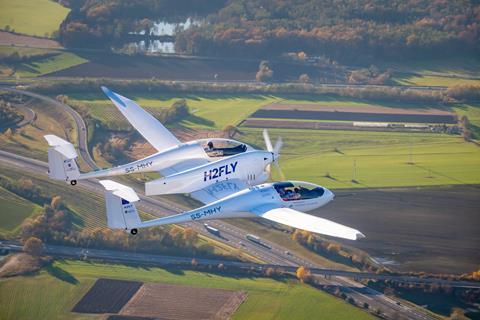Advanced powertrain integrator H2Fly has launched another round of flight tests with its hydrogen fuel cell-powered HY4 aircraft to assess component improvements to its 130kW system.
Taking place at Stuttgart airport in Germany, the test campaign with the twin-boom HY4 began on 24 February and will run until the middle of the year, says chief executive Dr Josef Kallo.

Now in its seventh generation, the powertrain has gained improved insulation and controls, says Kallo. In addition, H2Fly is working with the airport operator to better understand the infrastructure and procedures needed to support hydrogen-powered flights.
While not a production-ready system, the latest iteration is more than simply a proof-of-concept demonstrator, he says.
“The demonstration phase was six or seven years ago – this test campaign’s goal is to improve the controls and operation procedures and also to understand what would happen if they have to prove their redundancy.”
In order to simulate degraded operation, one test will see H2Fly “disconnect one fuel cell in flight and see what happens”.
Ultimately the aim is to ensure the system is “qualifiable before it needs to be scaled up”, he says. H2Fly has an agreement with German manufacturer Deutsche Aircraft to integrate a hydrogen fuel cell powertrain, including its storage system for the fuel, onto a D328eco – a modernised version of the Dornier 328 turboprop. This will require a total power output of around 1.5MW.
Development activities on the German government-backed project are under way, supporting a first flight of the fuel cell-powered 40-seater in 2025.

Kallo says the first components for the effort were ordered recently and should arrive in the coming weeks. A preliminary design review is planned for the third-quarter, followed by a critical design review around 18 months later.
Service entry for the hydrogen-powered D328eco could come as early as 2028, says Kallo, who sees a handful of the aircraft in operation that year; more widespread adoption would take place by 2030, he says.
Converting an existing aircraft has the advantage of minimising risk and allowing early adoption of the new fuel, says Kallo. But he acknowledges that to “really unlock” hydrogen’s potential, a new airframe design, such as a blended wing, will be needed in the longer term.
Although Deutsche Aircraft is the only disclosed customer for the system, Kallo says talks have taken place with other potential aircraft developers for both larger and smaller versions of its powertrain.
In future, a 6MW system is feasible, he says, which could power an aircraft with around 100 seats. But the D328eco project is an important first step “to go into the CS-25 [large aircraft category] environment and build a powertrain that can be used in the real world on a real product”.
He stresses that H2Fly has no ambition to be an airframer, instead maintaining its expertise in powertrain integration. “We will always need airframe partners,” he says.

Kallo is confident that hydrogen-electric aircraft, sized “like a minibus or a van”, can also unlock new markets on routes of up to 560nm (1,000km) through a combination of low operating costs, zero-emission propulsion and quiet operation. However, aviation security procedures would need to change to permit boarding times of around 5min, he thinks.
“If people get used to services like this and the cost goes down this will go berserk.”
Fuel-cell technology should ultimately permit flights of up to 2,000km “with a decent investment”, but long-haul services will likely require direct combustion of hydrogen in a gas turbine, Kallo says.
Although airlines may base their future propulsion decisions on the price differential between synthetic sustainable aviation fuel (SAF) and hydrogen, Kallo thinks wider cost considerations should come into play.
He points out that it will take an investment of €100-200 billion ($112-224 billion) to deliver the energy generation infrastructure required for sufficient green hydrogen production in Europe. In comparison, to scale up synthetic SAF production, an investment of $500 billion will be needed.


























